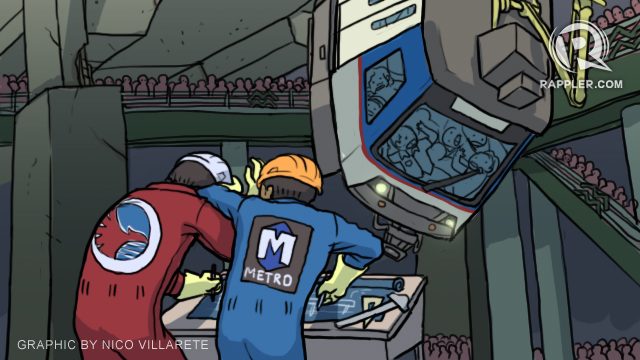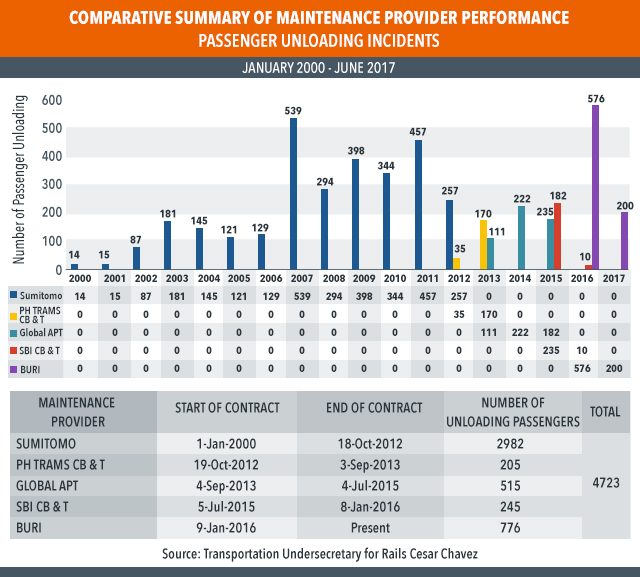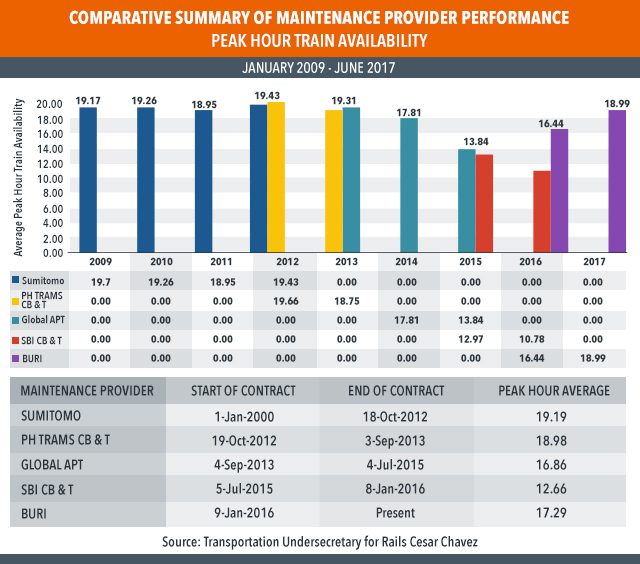SUMMARY
This is AI generated summarization, which may have errors. For context, always refer to the full article.

MANILA, Philippines – Amid climbing ridership and plummeting on-time performance, the nation’s busiest mass transit railway is jammed every morning with thousands of people waiting to board trains.
This year alone, the Metro Rail Transit Line 3 (MRT3) has recorded 31 service interruptions so far. The Department of Transportation (DOTr) said Korean-Filipino maintenance service provider Busan Universal Rail Incorporated (BURI) is at fault.
“In one and a half years, BURI has failed to maintain a safe and reliable MRT3 system, with 98 service interruptions and 833 passenger unloadings or almost twice a day, punctuated by unprecedented train derailments in April, May, and June 2017,” Transportation Undersecretary for Rails Cesar Chavez said in a text message.
This was Chavez’s response to BURI’s challenge to prove his allegations of incompetence against the company. BURI on Monday, August 28, asserted its previous contention that it has delivered more than what is required from its current contract of services.
Chavez had told lawmakers last week that his department is set to terminate the contract with the MRT3 maintenance service provider over the rising number of train service interruptions. (READ: DOTr to terminate MRT maintenance contract)

“To set the record straight, it is untrue that BURI has not been procuring proper spare parts. When BURI started its contract in January 2016, only 40 of MRT3’s 72 cars were running. These 40 cars were enough for only 13 3-car trains. The other cars were inoperable and had many missing parts,” Charles Mercado, legal counsel and spokesperson of BURI, said in a statement.
Since then, Mercado said BURI fixed 28 cars to “presently deliver the contract minimum of 18 trains for revenue operation.”
But Chavez told Rappler that under the concession agreement, BURI has been required to provide at least 20 trains during peak hours since November 2016.
He said that the MRT3 is regularly failing to meet its train schedules, especially during rush hour, leading to reduced train capacity.
Design or maintenance flaws?

Mercado said it is unfair to blame BURI for every glitch or train stoppage. He said the firm has reminded the transportation department to complete the MRT3’s rail replacement – an important factor in the system’s performance.
“That fact shows that the glitches are more reasonably due to design flaws – and not mainly maintenance issues. Through the years, the deterioration of the rails and passenger loading above the intended usage only worsened the system’s condition and resulted in more glitches,” Mercado said.
He added that BURI’s performance contributed significantly to the increase in the average daily ridership from a little over 300,000 daily in January 2016 to recent figures exceeding 450,000 – even reaching 500,000 at times, he said. (READ: Groups of Ramon Ang, MVP set sights on MRT3 upgrade)
But as train disruptions have become all too common, the DOTr has faced growing pressure. The government is in charge of the operations of the railway system, while a 3-year maintenance contract was awarded to BURI.
What the MRT3 needs is more capacity: trains that run more frequently and new lines to carry the growing population. But these fixes would take years and would cost billions of pesos to roll out.
About 48 new light rail vehicles (LRVs) were bought from China’s Dalian Locomotive & Rolling Stock Company for P3.8 billion during the Aquino administration. According to Chavez, these would be unserviceable for at least 3 years due to signaling issues.
BURI’s Mercado said issues like train and rail replacements are not under his firm’s 3-year maintenance contract with the government. “Undersecretary Chavez should be asked to disprove this evidence on the design flaws as opposed to insisting [on] the immediate cancellation of the MRT3 maintenance service contract,” he added.
But Chavez stood his ground, claiming most of the train derailments and service interruptions are due to poor maintenance and not attributable to design or rail issues. (READ: No more long lines by end-2017 – MRT3 management)
“BURI failed to regularly provide 20 sets of trains as evidenced by service interruptions, train removals, and train derailments; emphasis is that it has failed to provide [the] required number of reliable trains,” Chavez said.
At present, the MRT3 runs from North Avenue Station in Quezon City to Taft Avenue Station in Pasay City. In 2016, the railway system had 10.27 million passengers, up from the 9.85 million passengers recorded in 2015. – Rappler.com
Add a comment
How does this make you feel?
There are no comments yet. Add your comment to start the conversation.